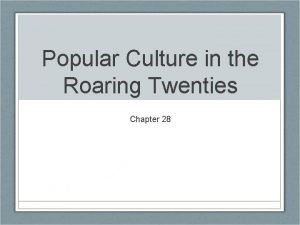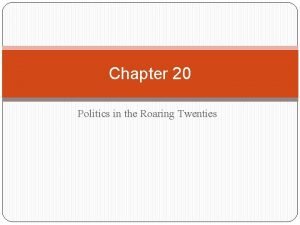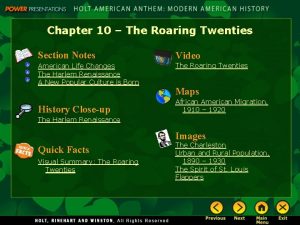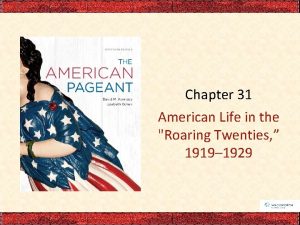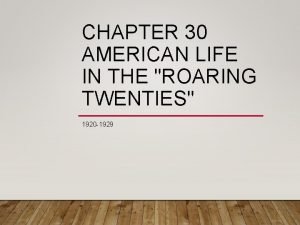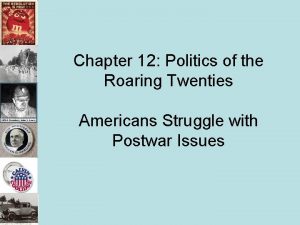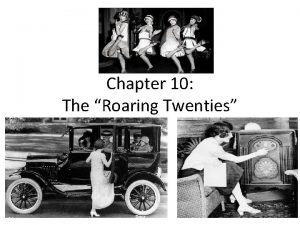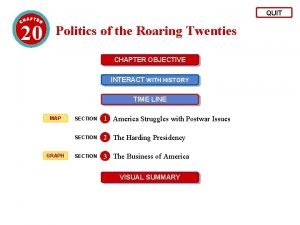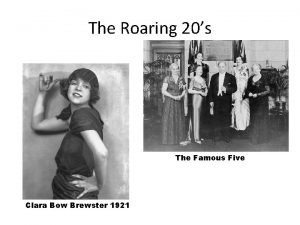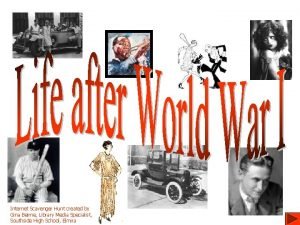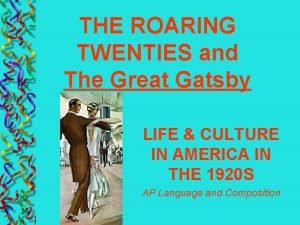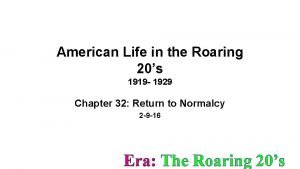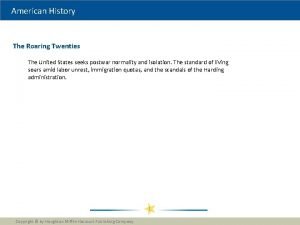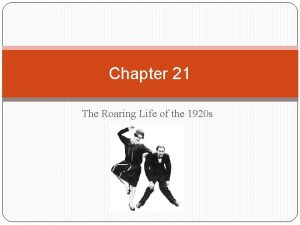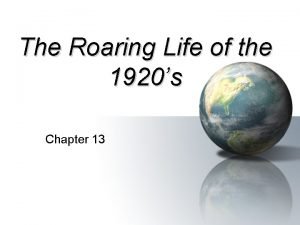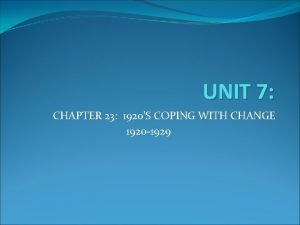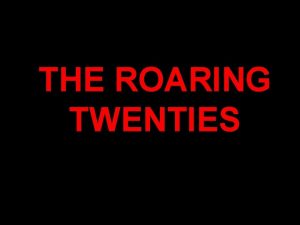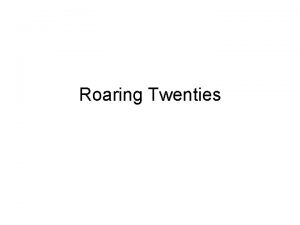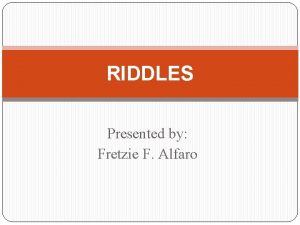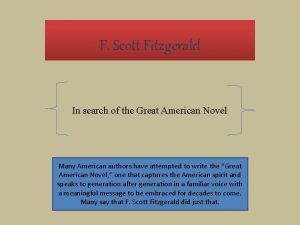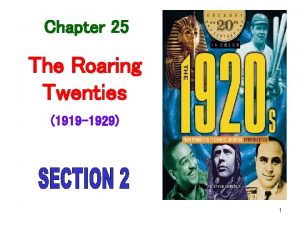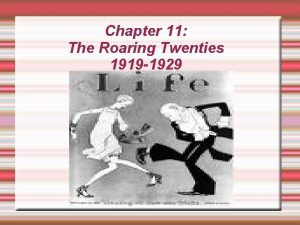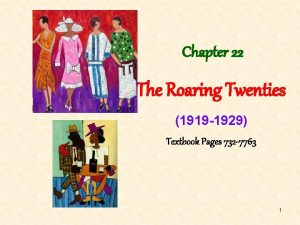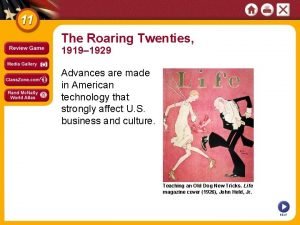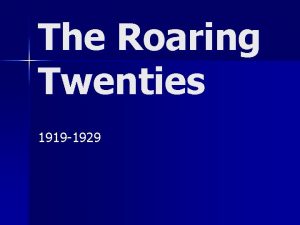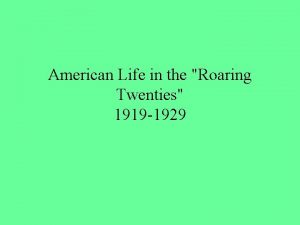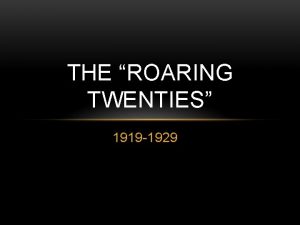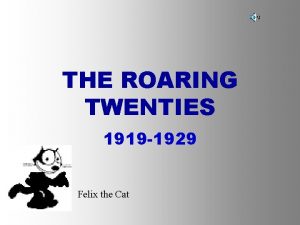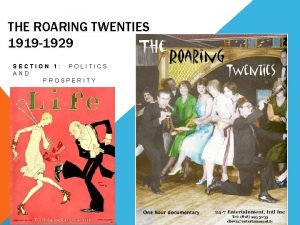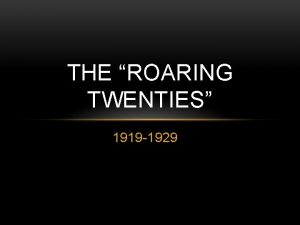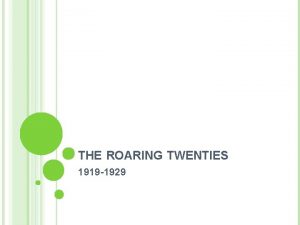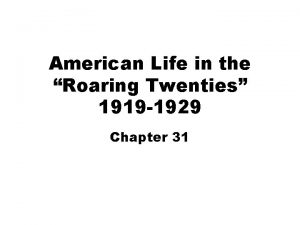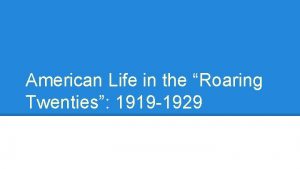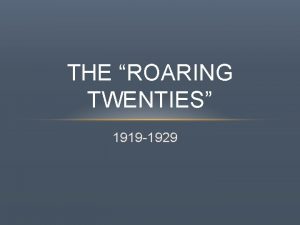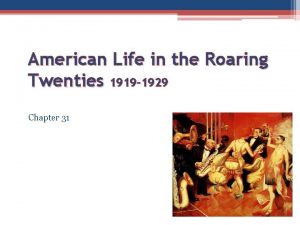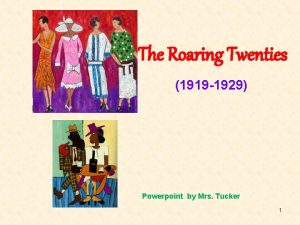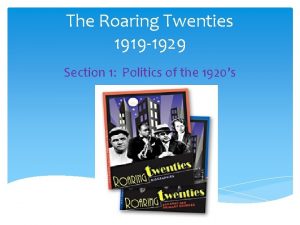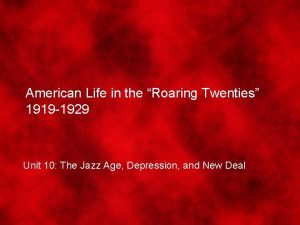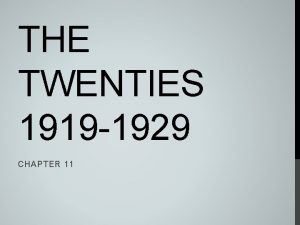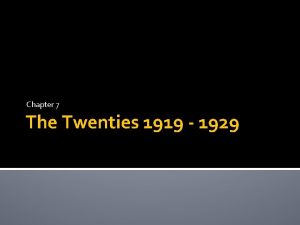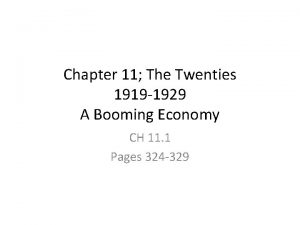Chapter 7 THE ROARING TWENTIES 1919 1929 The


























- Slides: 26

Chapter 7 THE ROARING TWENTIES (1919 -1929)

The Perception of the Twenties Prohibition and Flappers

The Perception of the Twenties � Prohibition The 18 th Amendment Manufacture, sale, and consumption of alcohol is illegal Illegal Alcohol “Bootleg” Liquor Smuggling the good stuff Homemade “bathtub” gin § No quality control § More like rubbing alcohol Distributed through illegal bars § Speakeasies Distributed by gangsters § § Al Capone Built his empire through the smuggling of alcohol Used violence and relationships with politicians Some viewed him as a “modern day Robin Hood” due to his donations to various charities § Saint Valentine’s Day Massacre ruined his image

The Perception of the Twenties Flappers Young women of the 1920’s New culture and social independence “new breed” of young Western women who wore short skirts, bobbed their hair, listened to jazz, and flaunted their disdain for acceptable behavior. Used excessive make-up, drinking, treating sex in a casual manor, smoking, driving automobiles Short skirts Short hair Living their own lives Clara Bow The “IT” Girl, rose to stardom in silent films of the 1920’s. got her nickname from the movie “It”. She personified the Roaring Twenties and was described as its leading sex symbol

The Rising Standard of Living Signs of new prosperity � Millions of homes and apartment buildings with the latest conveniences Enameled tubs, toilets, and wash basin became standard Unlimited how water, privacy, and clean white fixtures � Large number in rural America still used outdoor bathrooms Americans had more leisure time Work week reduced from 60 hours per week to 45 Paid vacation became prevalent Americans improve their diets Consumption of corn meal and potatoes declined Sales of fresh vegetables increased by 45% Health improved and life expectancy increased White men born in 1900 had a life expectancy of 48 and women 51 By 1930, men 59 and women 63 Black men born in 1900 had life expectancy of 33 and black women 35 By 1930 black men increased to 48 and black women 47 Education opportunities increased for most Americans In 1900, only 1 in 10 young people of high school age were actually in school By 1930, that number increased to 6 in 10 College enrollment also increased But only a small percentage went beyond high school during the decade

The Rise of the Modern Corporation Structure and Practice of American businesses were transformed in the 1920’s � Mergers increased during the decade at a rate greater than at any time since the end of the 1890’s What emerged was not monopolies, but oligopolies- an industry domination spread among a few large firms � New Managers Tried to keep employees working efficiently By 1930, the 200 largest corporations controlled almost half of the corporate wealth Introduced pensions, recreation facilities, cafeterias, and even paid vacations and profit-sharing plans This “welfare capitalism” was designed to reduce worker discontent and discourage labor unions

The Rise of the Modern Corporation The Workers’ Share Even though hundreds of thousands of workers improved their standard of living in the 1920’s, inequality grew Between 1923 -1929, real wages increased 21%, but corporate earnings increased by 66% The richest 5% of the population increased their share of the wealth from 25% to 33% The wealthiest 1% controlled a whopping 19% of all income Disparity among workers also increased Those employed on auto assembly lines seen their pay increase and their hours at work decrease Yet the majority of American working-class families could not move beyond subsistence One study showed that a family need to make between $2000 and $2400 in 1924 to maintain an “American standard of living. ” That year, 16 million families earned less than $2000

The Rise of the Modern Corporation Unions Although some workers prospered in the 1920’s, unions did not Union membership dropped to about 5 million in 1921 to under 3. 5 million in 1929 The National Manufacturing Association carries a vigorous campaign to restore the “open shop, ” while many businesses added pensions and company unions to lure employees away from unions All other unions suffered the same losses


New Technology and its Effect on the American Life Automobiles � Henry Ford, founder of the Ford Motor Company While he did not invent the auto or the auto assembly line, he did manufacture the first auto that middle-class America could afford The moving assembly line Model T Cut production time for one car from 14 hours to 1½ hours The product of the carefully planned assembly line The prototype of the inexpensive family car Changing American Life There were nearly 1 million autos in 1912 In 1929, Americans purchased 4. 5 million cars Autos stimulated and transformed the petroleum, steel, and rubber industries Forced the construction of streets and highways Created new suburbs and allowed families to live miles away for the workplace Gasoline stations, diners, and tourist locations became familiar landmarks Small crossroad stores and many small churches disappeared Trucks and tractors changed farming Buses began to eliminate one-room schools Courting habits changed and young people were able to leave the watchful eye of parents Advertising made the auto the symbol of the good life, sex, freedom, and speed By 1926, 75% of cars sold were bought on some kind of deferred payment plan, “buy now, pay later” As more vehicles were sold, the price continued to lower Model T in 1912 cost $600

New Technology and its Effect on the American Life Downside of the Automobile Oil and gasoline contaminated streams Piles of old tires were everywhere Rusting hulks of discarded cars began to line the highways Emissions from thousands and then millions of internal combustion engines fouled the air Commercial Radio First radio stationed appeared in 1920 and they broadcasted election results � The next year a Newark station broadcast the World Series � In 1922, a radio station broadcast the first commercial � Much of the broadcasting consisted of classical music � Soon added news analysis and coverage of important events Serials and situation comedies made radio a national medium, with millions tuning into the same program By the end of the decade, people everywhere were humming the same popular songs, while actors and announcers became

New Technology and its Effect on the American Life Movies � 40 million viewers a week went to the movies in 1922, and by 1929 the total movie goers exceeded 100 million Movie stars were more famous than politicians Before the war, movie goers were generally the working-class, but after the war everyone went Babe Ruth and Jack Dempsey were famous movie stars Sports owed much of its popularity to the auto, movies, and mass production of newspapers Thousands drove to college towns to watch football Millions listened for scores or read about the games the next day 1927 marked a new beginning of the new age of Mechanization and progress � � � Henry Ford produced his 15 th million auto Radio-Television service linked San Francisco to Manila The first radio network was organized (CBS) The first sound movie was released (The Jazz Singer) The first underwater vehicular roadway connected New York and New Jersey (The Holland Tunnel) Charles Lindbergh flew his single-engine plane from New York to Paris and captured the world with his daring feat


Reactions to Change Traditionalist vs. Modernists � The First Red Scare The Russian Revolution of 1917 suddenly made the Bolshevik the most dangerous radical, some how mixed with the other villain, the Germans “Red” came to be the symbol for Communism, and the teachings of Karl Marx (the Communist Manifesto) stood in stark contrast to the way of life envisioned by America capitalism Immediately after the war there was between 25, 000 and 40, 000 American Communists Nationwide strikes were blamed on the Bolsheviks In 1919, a series of devastating strike occurred across America From 1914 -1919 wartime inflation caused prices to nearly double while wages remained the same In 1919, more than 4 million workers staged 4, 000 strikes They demanded higher wages, shorter hours, and sometimes more control over the workplace

Reactions to Change � “Bomb-Throwing Radicals” April 28, 1919, a bomb was discovered in a small package delivered to the home of Seattle mayor The next day, the maid of a former Senator open a package and had her hands blown off In June, a bomb shattered the front of Attorney General A. Mitchell Palmer’s home � � In the summer of 1919, Palmer decided to destroy the “Red” network Appointed J. Edgar Hoover to lead a special antiradical division within the Justice Department Hoover coordinated information on domestic radical activity Palmer instituted a series of raids to round up radical foreign workers, “the Red Menace. ” In December, 249 aliens were deported, although few had any desire to overthrow the government The Palmer Raids, probably the most massive violation of civil liberties in America up to that time, found few dangerous radicals, but did increase fear and intolerance Many patriotic organizations and societies were determined to purge Communists

Reactions to Change The Revival of the KKK (1920’s) among the super-patriotic organizations claiming to protect the American way of life � William Simmons (Georgia)- lay preacher, salesman, and member of many fraternal organizations. He adopted the name and white-sheet garb of the old Anti-Black Reconstruction organization that was glorified in the 1915 film “Birth of a Nation” Appointed himself the Imperial Wizard The “old” Klan focused specifically on limiting or restricting black peoples and anyone that aided in their cause The “New” Klan Several million join Thoroughly White Anglo-Saxon Protestant (WASP) Anti-foreign, supported immigration restrictions Anti-Semitic and Anti-Catholic Denounced short skirts, petting, and demon rum Upheld patriotism and purity of women Grew slowly after the war but added over 100, 000 in 1920 alone Flourished in small towns and the rural South Especially strong in working-class neighborhoods Chicago, Detroit, Indianapolis, and Atlanta Many of its members were women who campaigned for more rights for white-protestant women Klan influenced politics, especially in Indiana, Oregon, Oklahoma, Louisiana, and Texas Eventually shoots itself in the foot Declining in the mid-1920’s

Reactions to Change Sacco and Vanzetti Case (1920 -1927) � One result of the Red Scare and fear of foreign radicals was the conviction and sentencing of two Italian anarchists The Crime The Trial Many intellectuals in America and Europe rallied to their defense Appeal after appeal failed Massive protests and midnight vigils around the country The Execution Convicted on what many considered flimsy evidence Many felt the conviction was based on their broken English skills and their foreign appearance The Controversy Arrested in 1920 for allegedly murdering a guard during a robbery in Minnesota Both men were electrocuted on August 23, 1927 The continuing debate Recent evidence, including ballistic tests, suggests that they may have been guilty, but the trial and its after math pointed to the ethnic prejudice and divisions in American society

Reactions to Change The Scopes Monkey Trial (1925) � Battle over teaching theory of evolution in high school in the little town of Dayton, Tennessee, symbolized the clash of Tradition vs. Modern, city vs country Theory of Evolution Religious Fundamentalism The Defense- Clarence Darrow, famous lawyer (agnostic) The Prosecution- William Jennings Bryan represented the World Christian Fundamentalist Association Bryan was very old and tired at this time Died a few days after the trial The Conclusion He was arrested for breaking the law The Trial High School Biology teacher decided to teach theory The Crime Evolutionary teaching stood against traditional faith in God. As a result, the teaching of evolutionary theory was outlawed in many school districts in some states John Scopes Evolution is change in heritable traits of biological populations over successive generation Jury found Scopes guilty and he paid a $100 fine Results of the Trial Many Evangelical Protestants, who saw the Bible as the literal truth, viewed the dramatic changes in the 1920’s as a major spiritual crisis Enrollment in Christian colleges and the circulation of fundamentalist publications increased dramatically from 1920 -1930 Popular preachers attracted huge audiences on weekly radio broadcasts

Reactions to Change The Harlem Renaissance � African American experiences during World War I � Alain Locke, the first black Rhodes Scholar, was the father of the Harlem Renaissance � The Great Migration African American Soldiers His book “The New Negro” announced the movement to the outside world and outlined black contributions to American culture and civilization Revival of African American art and culture Langston Hughes, poet and novelist, wrote bitter and humorous poems, using black vernacular to describe the pathos and pride of African Americans “Weary Blues” he adapted the rhythms of jazz and the blues Jamaican Claude Mc. Kay, wrote about the underside of life in Harlem in “Home to Harlem” Portrayed two black men One, Jake, who finds a life simple and filled with erotic pleasures in Harlem cabarets The other, an Intellectual, unable to make such an easy choice and conscious that “my damned white education has robbed me of…primitive vitality”

Reactions to Change � Jazz An important force in Harlem in the 1920’s Prosperous whites came to hear Louis Armstrong, Duke Ellington, and other black musicians American Jazz was also imported to Europe � During Over the 1920’s 117, 000 whites left Harlem Over 87, 000 African Americans moved into Harlem

The Politics of the 1920’s Election of 1920 � Warren G. Harding (Republican) nominee. Roosevelt had died in 1919 so the party chose someone new “Return to Normalcy” Return to Laissez-faire politics Calvin Coolidge, the Vice President selection Governor James Cox the Democratic Nominee Franklin D. Roosevelt, Assistant Secretary of the Navy, Vice President selection � Landslide victory for Republicans Harding’s 60. 4% margin in victory was the largest in US History Less than 50% of voters went to the polls Newly enfranchised women, especially the working-class neighborhoods, avoided the voting booths Also, large numbers of men avoided the vote Many simply did not care who the president was

The Politics of the 1920’s � Harding’s Presidency (1921 -1923) The smoke filled White House � Teapot Dome Scandal Corruption and scandal- Secretary of the Interior Albert Fall had illegally leased government-owned oil reserves in the Teapot Dome section of Wyoming to businessmen for over $300, 000 in bribes � A visitor to the White House noted that Harding and his cohorts discussing the problems of the day with “the air heavy with tobacco smoke, tray with bottles containing every imaginable brand of whiskey. ” He called a conference on disarmament and another on unemployment Only after Coolidge becomes president do the full extent of Harding’s scandal come to light Illegal activities turned up in the Veteran’s Administration and elsewhere Harding’s attorney resigned in disgrace The Secretary of the Navy barely avoided prison Two of Harding’s advisors committed suicide Albert Fall went to jail Harding was not personally corrupt Harding’s Death Sudden death in August of 1923 American genuinely mourned his death

The Politics of the 1920’s Election of 1924 � Coolidge’s Presidency (1923 -1929) Republican “Silent Cal” Was little question who would win Democrats were in serious dysfunctional mode Secretary of the Treasury was Andrew Mellon Quiet, laissez-faire, and honest Represented old fashion values Simple religious faith Personal integrity Immensely popular Created federal income tax exempted most families by giving everyone a $2500 exemption, plus $400 for each dependent In 1928, Congress slashed taxes further, removed most excise taxes, and lowered the corporate tax rate The 200 largest corporations increased their assets during the decade from $43 billion to $81 billion Coolidge’s primary goal as president was, “the chief business of the American people is business”

The Politics of the 1920’s Election of 1928 � Herbert Hoover (Republican) Coolidge decides not to run again for president Hoover was easy choice for Republicans Self-made millionaire War humanitarian Alfred Smith, Catholic Governor of New York won the Democrat nomination � Hoover Gets wins big 444 electoral votes to 76 for Smith

The Politics of the 1920’s A Golden Age? US seemed to be headed towards a golden age In 1928 and 1929, money could be made everywhere Real estate Business ventures Stock Market § In fact, stock market ventures were so successful that everyone was playing the game. It was a sure way to make money Then the “orgy” started § In 1928, the market zoomed to 331 § Money that had normally went into houses, cars, and other goods was now going to stocks § In September of 1929, the New York Times Index peaked at 452, and then it began to drift downward § By mid-November, the market had plummeted to 224, a loss on paper of over $26 billion § Still, one month later, many businessmen started spending more money on stocks thinking the market had reached its lowest point § By the end of November in 1929, the stock market had completely collapsed, and every American suffered enormous losses beyond anything they had ever experienced before

Roaring Twenties Movie https: //www. youtube. com/watch? v=RN 7 fty. Zig Ys
 Chapter 28 popular culture in the roaring twenties
Chapter 28 popular culture in the roaring twenties Chapter 20 section 2 the harding presidency
Chapter 20 section 2 the harding presidency Chapter 10 the roaring twenties
Chapter 10 the roaring twenties Chapter 31 american life in the roaring twenties
Chapter 31 american life in the roaring twenties Chapter 30 american life in the roaring twenties
Chapter 30 american life in the roaring twenties Chapter 12 politics of the roaring twenties
Chapter 12 politics of the roaring twenties Chapter 10 the roaring twenties
Chapter 10 the roaring twenties Chapter 20 politics of the roaring twenties answer key
Chapter 20 politics of the roaring twenties answer key Chapter 20 politics of the roaring twenties
Chapter 20 politics of the roaring twenties The roaring twenties were characterized by –
The roaring twenties were characterized by – Roaring twenties acrostic poem
Roaring twenties acrostic poem Roaring twenties scavenger hunt answers
Roaring twenties scavenger hunt answers The roaring twenties canada
The roaring twenties canada Roaring twenties great gatsby
Roaring twenties great gatsby Roaring twenties acrostic poem
Roaring twenties acrostic poem The roaring twenties lesson 3 changing ways of life
The roaring twenties lesson 3 changing ways of life Chapter 21 the roaring life of the 1920s
Chapter 21 the roaring life of the 1920s Chapter 13 the roaring life of the 1920s
Chapter 13 the roaring life of the 1920s Chapter 23 activity: coping with change, 1920-1929
Chapter 23 activity: coping with change, 1920-1929 Her memory is cloudy since she can never remember anything.
Her memory is cloudy since she can never remember anything. Roaring 20s vocabulary
Roaring 20s vocabulary Act 4 scene 1 romeo and juliet summary
Act 4 scene 1 romeo and juliet summary Demobilization and adjustment to peace 1920
Demobilization and adjustment to peace 1920 20s decade fashion
20s decade fashion Tigmo tigmo agokoy ugma ra kita mag asoy
Tigmo tigmo agokoy ugma ra kita mag asoy The roaring 20’s / jazz age
The roaring 20’s / jazz age Roaring rockets powerpoint
Roaring rockets powerpoint
